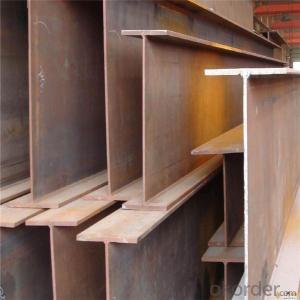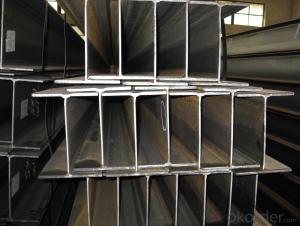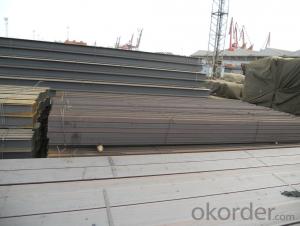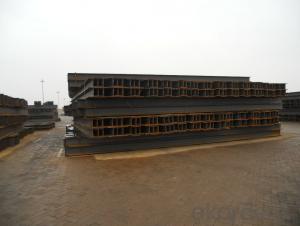GB Hot Rolled H Steel Beams Supplier from China
- Loading Port:
- Dalian
- Payment Terms:
- TT OR LC
- Min Order Qty:
- 125 m.t
- Supply Capability:
- 150000 m.t/month
OKorder Service Pledge
OKorder Financial Service
You Might Also Like
Item specifice
Quick Detail
Standard: | ASTM, GB, JIS | Grade: | Q235Q345ss400ss490 | Dimensions: | HM100*100*6*--8#428*407*20*35 |
Place of Origin: | Hebei, China (Mainland) | Brand Name: | JINXI | Type: | Alloy Structural Steel |
Application: | roof beam | Shape: | Beams | price: | competitive |
We can provide qualify goods,competitive price and speedy delivery.
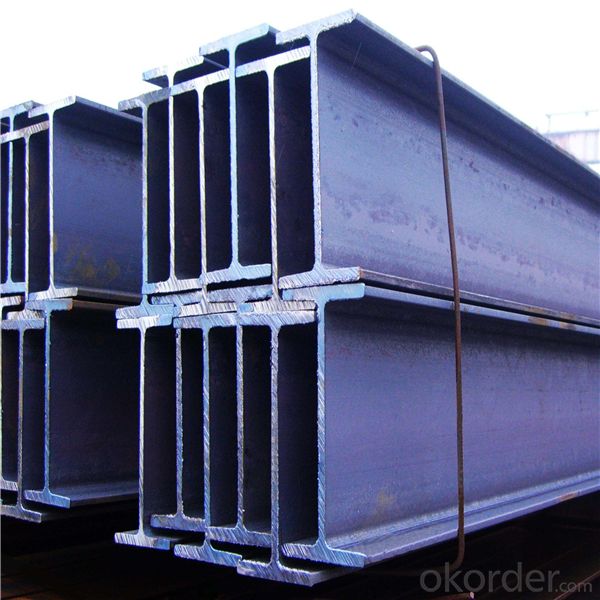
Products Description
Description | High Frenquency Thin-walled H Beam | |
Product Name | H Beam | |
Specification | Height:75-500mm Width:50-250mm | |
Standard | GB700-1998,GB/T1591-1994 | |
Material | Q235B,Q345B | |
Application | a. Bridge and post structures in industry and civil use of steel construction. | |
Certificates | ISO,SGS,BV,TUV,Lloyd | |
MOQ | 20 tons or according to customers’ requirement. | |
Port of Delivery | Tianjin Port of China | |
Remarks | We can provide qualify goods,competitive price and speedy delivery |
Packaging & Delivery
Packaging Details: | Packed with waterproof paper and steel banding. |
Delivery Detail: | 15-25 |
FAQ
1. How can I get some samples?
We are honored to offer you samples. New clients are expected to pay for the courier cost. The samples are free for you.
2 Do you have any certificates?
Our products passed inspection of SGS, FDA, and CE Quality is priority! Every worker keeps the QC from the very beginning to the very end, Quality control department especially responsible for quality checking in each process.
3 Can your factory print or emboss my logo on the goods?
Yes, we can print or emboss the logo on the goods or their packing box.
4 What information should I let you know if I want to get a quotation?
1) The specification of products (length x width x thickness);
2) The temper and alloy.
3) The final product you will use to be made
4 It will be better if you can show us the pictures or design sketch. Samples will be best for clarifying. If not, we will recommend relevant products with details for reference.We usually produce goods based on customers
Samples or based on customers’ picture, logo, sizes etc.
- Q:What are the different applications of steel H-beams?
- Steel H-beams have a wide range of applications in various industries due to their structural strength and versatility. Some of the different applications of steel H-beams include: 1. Construction: Steel H-beams are commonly used in the construction industry for structural support in buildings, bridges, and other infrastructure projects. They provide excellent load-bearing capabilities, making them ideal for supporting heavy loads and spanning long distances. 2. Industrial Manufacturing: Steel H-beams are also used in the manufacturing sector for constructing frames and supports for heavy machinery and equipment. Their strong structural properties allow them to withstand the weight and vibrations generated by industrial processes. 3. Automotive Industry: Steel H-beams are utilized in the automotive industry for manufacturing chassis frames and structural components of vehicles. The high strength and durability of steel make it an ideal material for ensuring the safety and stability of automobiles. 4. Shipbuilding: Steel H-beams find extensive use in shipbuilding due to their ability to withstand harsh marine environments and support the weight of large vessels. They are commonly employed in the construction of ship hulls, decks, and structural components. 5. Aerospace Industry: Steel H-beams are employed in the aerospace industry for various applications, including aircraft frames, fuselage structures, and landing gear supports. The high strength-to-weight ratio of steel makes it a suitable material for ensuring the structural integrity of aircraft. 6. Railway Infrastructure: Steel H-beams are widely used in the railway industry for constructing railway bridges, platforms, and tracks. Their robustness and load-bearing capacity make them suitable for withstanding heavy train traffic and maintaining stability. 7. Mezzanine Floors: Steel H-beams are commonly utilized in the construction of mezzanine floors, which provide additional storage space or work areas in commercial buildings. The beams support the weight of the floor and any loads placed on it. 8. Transmission Towers: Steel H-beams are employed in the construction of transmission towers used for power lines and telecommunication networks. The beams provide the necessary structural strength to support the weight of the cables and withstand external forces such as wind and seismic loads. Overall, steel H-beams have diverse applications across several industries due to their structural strength, durability, and versatility. Their ability to support heavy loads and span long distances makes them an ideal choice for various construction, manufacturing, transportation, and infrastructure projects.
- Q:How do steel H-beams perform in areas with high seismic activity?
- Steel H-beams are widely recognized for their superior performance in areas with high seismic activity. The structural design of H-beams allows them to effectively absorb and dissipate seismic energy, making them highly resilient to earthquakes. One key factor contributing to the excellent performance of steel H-beams in seismic areas is their inherent strength and stiffness. H-beams are made of high-strength steel, which can withstand significant forces and deformations without collapsing or losing integrity. This strength helps minimize damage to the structure and ensures the safety of occupants. Moreover, the shape of H-beams provides an added advantage in seismic regions. The horizontal flanges and vertical web of the beam work together to distribute the seismic loads evenly across the structure. This distribution of forces helps prevent localized stress concentrations and reduces the likelihood of structural failure during an earthquake. Additionally, steel H-beams can be designed to incorporate connections that offer enhanced seismic resistance. These connections are designed to allow for some flexibility and rotation, enabling the beams to accommodate the movement and deformation caused by seismic activity. This flexibility helps dissipate the seismic energy and minimizes potential damage to the building. Furthermore, steel is inherently ductile, meaning it can undergo significant deformation before failing. This ductility is crucial in seismic areas, as it allows the steel H-beams to absorb and dissipate seismic energy by undergoing controlled deformations. This ability to absorb energy helps protect the overall structure and ensures the safety of the occupants. In conclusion, steel H-beams are an excellent choice for areas with high seismic activity. Their strength, stiffness, and ductility make them highly resilient to seismic forces, enabling them to effectively absorb and dissipate seismic energy. The design and shape of H-beams, along with their connections, further enhance their performance in seismic regions. Ultimately, steel H-beams provide a reliable and safe structural solution in areas prone to earthquakes.
- Q:Can steel H-beams be customized to specific project requirements?
- Yes, steel H-beams can be customized to specific project requirements. These beams are commonly used in construction and structural engineering projects due to their strength and versatility. Steel H-beams can be customized in terms of size, length, and shape to meet the specific needs of a project. The customization process may involve cutting, welding, or shaping the beams to fit the desired dimensions and specifications. Additionally, other features such as bolt holes or notches can also be added to the beams as per the project requirements. This flexibility allows engineers and architects to design and construct buildings and structures that are tailored to their specific needs, ensuring optimal performance and safety.
- Q:Are steel H-beams suitable for use in the construction of entertainment venues or stadiums?
- Yes, steel H-beams are suitable for use in the construction of entertainment venues or stadiums. Steel H-beams are commonly used in construction due to their strength, durability, and versatility. They provide excellent structural support and can withstand heavy loads, making them ideal for large-scale projects such as stadiums or entertainment venues. Steel H-beams offer several advantages for these types of constructions. Firstly, they have a high load-carrying capacity, allowing them to support the weight of large crowds, seating structures, and equipment. Additionally, their long spans and ability to resist bending make them suitable for creating large open spaces, such as sports arenas or concert halls. Moreover, steel H-beams have a high resistance to fire, which is crucial for ensuring the safety of occupants in entertainment venues. They can withstand high temperatures and provide a considerable amount of time for evacuation in case of a fire incident. This fire-resistant characteristic of steel H-beams makes them a reliable choice for venues where a large number of people gather. Furthermore, steel H-beams can be fabricated and pre-engineered off-site, allowing for faster construction and reduced costs. They can be easily transported and assembled, thereby expediting the construction process and minimizing disruption to surrounding areas. Lastly, steel H-beams have a long lifespan and require minimal maintenance. They are resistant to corrosion and deterioration, ensuring the longevity of the structures they support. In conclusion, steel H-beams are highly suitable for use in the construction of entertainment venues or stadiums due to their strength, durability, versatility, fire resistance, and cost-effectiveness. They offer the necessary structural support and safety features required for these types of large-scale projects, making them a preferred choice for architects and engineers in the industry.
- Q:Are steel H-beams suitable for use in the construction of residential houses?
- Yes, steel H-beams are suitable for use in the construction of residential houses. They provide excellent structural support, are durable, and can withstand heavy loads. Additionally, their versatility allows for flexibility in architectural designs, offering homeowners a wide range of possibilities.
- Q:Are steel H-beams suitable for use in the construction of government institutions or buildings?
- Yes, steel H-beams are suitable for use in the construction of government institutions or buildings. Steel H-beams are known for their strength, durability, and load-bearing capabilities, making them highly suitable for projects that require structural integrity and long-lasting performance. Additionally, steel H-beams offer design flexibility, allowing architects and engineers to create efficient and aesthetically pleasing structures.
- Q:How do you calculate the load-bearing capacity of steel H-beams?
- In order to determine the load-bearing capacity of steel H-beams, several factors must be taken into consideration. To begin, it is necessary to calculate the cross-sectional area of the H-beam by measuring the dimensions of the flanges and web. The flanges, which are the horizontal sections of the H-beam, and the web, which is the vertical section connecting the flanges, play a crucial role in this calculation. Following that, the material properties of the steel being used, including the yield strength and modulus of elasticity, need to be identified. The yield strength represents the maximum stress the steel can withstand without experiencing permanent deformation, while the modulus of elasticity measures the material's stiffness. Once these parameters are known, the moment of inertia of the H-beam can be calculated. The moment of inertia provides insight into the beam's resistance to bending and depends on the shape and dimensions of its cross-section. Using the moment of inertia, the section modulus can be determined. The section modulus, which is the ratio of the moment of inertia to the distance from the neutral axis of the beam to the extreme fiber, indicates the beam's resistance to bending and is utilized to ascertain its load-bearing capacity. Finally, the load-bearing capacity of the steel H-beam can be calculated by dividing the section modulus by a safety factor. The safety factor takes into account uncertainties in the design and manufacturing processes and guarantees that the beam can withstand loads without excessive deflection or failure. The precise safety factor to be utilized depends on the intended application and the level of risk involved.
- Q:Can steel H-beams be used for overhead crane systems?
- Yes, steel H-beams can be used for overhead crane systems. Steel H-beams are commonly used as the main structural support for overhead crane systems due to their high strength and durability. The H-shaped cross-section of the beam provides excellent load-bearing capabilities, making it suitable for supporting heavy loads and withstanding the dynamic forces experienced during crane operations. Additionally, steel H-beams can be easily connected and assembled to create the required crane structure. Overall, steel H-beams are a popular choice for overhead crane systems due to their reliability and suitability for heavy-duty applications.
- Q:Can steel H-beams be used in the construction of cultural complexes or museums?
- Yes, steel H-beams can be used in the construction of cultural complexes or museums. Steel H-beams are commonly used in construction projects due to their strength, durability, and versatility. They provide structural support, allowing for the creation of large open spaces and unique architectural designs. Additionally, steel H-beams can be easily fabricated and assembled, making them suitable for complex and intricate structures often found in cultural complexes or museums.
- Q:How do steel H-beams contribute to sustainable building certifications?
- Steel H-beams have a significant impact on sustainable building certifications in various ways: 1. Enhancing Energy Efficiency: Structural frames made from steel H-beams maximize energy efficiency by providing a high strength-to-weight ratio. This allows for the use of smaller columns and beams, reducing the need for excessive amounts of steel and concrete. Consequently, energy consumption during both construction and operation of the building is reduced. 2. Promoting Recyclability: Steel H-beams are manufactured using recycled materials and can be fully recycled at the end of their lifespan. This makes them an excellent choice for sustainable construction, as they can be reused or repurposed. This not only reduces the demand for new materials but also minimizes waste generation. 3. Ensuring Durability and Longevity: Steel H-beams possess exceptional durability and can withstand extreme weather conditions, seismic activities, and fire. This longevity eliminates the need for frequent maintenance or replacement, resulting in lower life-cycle costs and a reduced environmental impact throughout the building's lifespan. 4. Minimizing Waste and Emissions: The precise manufacturing process of steel H-beams results in minimal construction waste. Furthermore, their lightweight nature enables easier transportation and handling, thereby decreasing carbon emissions associated with transportation and installation. 5. Offering Design Flexibility: Steel H-beams provide architects and engineers with greater design flexibility, enabling the implementation of innovative and sustainable construction practices. Their ability to span larger distances without additional support columns allows for open floor plans and maximizes natural light, reducing the reliance on artificial lighting and enhancing indoor environmental quality. 6. Contributing to LEED Certification: Steel H-beams can earn points towards LEED certification, a globally recognized sustainability rating system for buildings. Their efficient utilization of materials, energy, and resources aligns with several LEED criteria, including Sustainable Sites, Energy and Atmosphere, Materials and Resources, and Innovation in Design. In conclusion, steel H-beams play a critical role in obtaining sustainable building certifications by offering energy efficiency, recyclability, durability, waste and emission reduction, design flexibility, and the potential to contribute to LEED certification. Their sustainable attributes make them the preferred choice for environmentally conscious builders and significantly contribute to achieving sustainable building goals.
1. Manufacturer Overview |
|
|---|---|
| Location | |
| Year Established | |
| Annual Output Value | |
| Main Markets | |
| Company Certifications | |
2. Manufacturer Certificates |
|
|---|---|
| a) Certification Name | |
| Range | |
| Reference | |
| Validity Period | |
3. Manufacturer Capability |
|
|---|---|
| a)Trade Capacity | |
| Nearest Port | |
| Export Percentage | |
| No.of Employees in Trade Department | |
| Language Spoken: | |
| b)Factory Information | |
| Factory Size: | |
| No. of Production Lines | |
| Contract Manufacturing | |
| Product Price Range | |
Send your message to us
GB Hot Rolled H Steel Beams Supplier from China
- Loading Port:
- Dalian
- Payment Terms:
- TT OR LC
- Min Order Qty:
- 125 m.t
- Supply Capability:
- 150000 m.t/month
OKorder Service Pledge
OKorder Financial Service
Similar products
New products
Hot products
Related keywords
